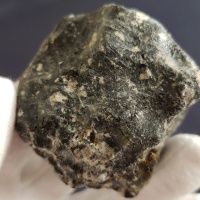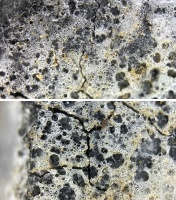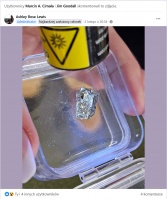(Unless otherwise stated, the copyright of the materials included belong to Jan Woreczko & Wadi.)
Ribbeck/Badania
Z Wiki.Meteoritica.pl
m (→Mineralogia) |
m (→Bibliografia) |
||
| Linia 86: | Linia 86: | ||
== [[Bibliografia]] == | == [[Bibliografia]] == | ||
| + | |||
| + | * Bischoff Addi, Patzek Markus, Barrat Jean-Alix, Berndt Jasper, Busemann Henner, Degering Detlev, Di Rocco Tommaso, Ek Mattias, Harries Dennis, Godinho Jose R.A., Heinlein Dieter, Kriele Armin, Krietsch Daniela, Maden Colin, Marchhart Oscar, Marshal Rachael M., Martschini Martin, Merchel Silke, Möller Andreas, Pack Andreas, Raab Herbert, Reitze Maximilian P., Rendtel Ina, Rüfenacht Miriam, Sachs Oliver, Schönbächler Maria, Schuppisser Anja, Weber Iris, Wieser Alexander, Wimmer Karl, (2024), '''Cosmic pears from the Havelland (Germany): [[Ribbeck]], the twelfth recorded aubrite fall in history''', ''Meteoritics & Planetary Science'', xx, 2024, ss. 35. Plik {{!doi|10.1111/maps.14245}}. | ||
* '''Meteoritical Bulletin Database ([http://www.lpi.usra.edu/meteor/metbull.php MBD])''' – meteoryt [http://www.lpi.usra.edu/meteor/metbull.php?code=81447 Ribbeck] | * '''Meteoritical Bulletin Database ([http://www.lpi.usra.edu/meteor/metbull.php MBD])''' – meteoryt [http://www.lpi.usra.edu/meteor/metbull.php?code=81447 Ribbeck] | ||
Wersja z 08:28, 1 sie 2024
Hasło powstało w oparciu o informacje dostępne na portalu facebook i dzięki życzliwości poszukiwaczy. Dziękujemy.
Spis treści |
Mineralogia
Za Meteoritical Bulletin Database:
Petrography: (A. Greshake, C. Hamann, L. Hecht, MNB) The meteorite is a coarse-grained achondritic breccia predominantly composed of large, up to 1.2 cm sized, mostly angular whitish enstatite grains, less abundant, up to 1.5 mm sized forsterite crystals, and minor sodic feldspar set in a fine-grained interstitial cataclastic matrix consisting of related material. Opaque phases include troilite, alabandite, oldhamite, heideite, keilite, djerfisherite, kamacite, and taenite. Enstatite and forsterite show pronounced undulatory extinction. All phases are intensely fractured and enstatite contains several sets of planar cracks. No diopside detected.
Geochemistry: Enstatite: Fs0Wo0.7±0.1 (Fs0Wo0.6-0.9, n=10); olivine: Fa0, n=10; plagioclase: An1.4-4.8Ab93.1-96.2Or2.0-2.4, n=5); troilite contains : 0.18±0.01 wt% Cr and 0.94±0.3 wt% Ti, N=3; kamacite contains : 4.65±0.11 wt% Ni, 0.94±0.2 wt% Co, and 0.07±0.01 Si, N=3; taenite contains : 32.4±0.3 wt% Ni, 0.56±0.2 wt% Co, and 0.10±0.01 Si, N=3
Mieszko Kołodziej informował o zaobserwowaniu w okazach meteorytu Ribbeck siarczku chromu brezinaitu (brezinaite, Cr3S4).
Alan Mazur sfotografował purpurowy kryształ wewnątrz okazu, prawdopodobnie halitu (NaCl, popularna sól kuchenna).[1]
Kryształy enstatytu. Okaz 9,2 g z kolekcji Pawła Zaręby (fot. Paweł Zaręba) |
||
Okazy aubrytu Tiglit[2], które są bardzo podobne do okazów meteorytu Ribbeck! |
Skorupa obtopieniowa
Za Meteoritical Bulletin Database:
Physical characteristics: (A. Greshake, C. Hamann, L. Hecht, MNB) The various individuals show rounded, egg-shaped, and angular shapes, have a gray-white patchy appearance and are partly to fully covered by fresh, whitish to dark grayish, often intensely cracked fusion crust. In many cases, the fusion crust contains transparent, often highly vesicular areas that appear to cover the dull gray and dull white areas in the form of thin veneers or stringers of quenched melt. Some rocks are fragmented, thereby exposing the whitish interior with large mineral grains already visible to the naked eye.
Skorupa obtopieniowa (ang. fusion crust, niem. Schmelzkruste, Schmelzrinde, fr. croûte de fusion, ros. кора плавления) na okazach meteorytu Ribbeck.
Okazy posiadające jasną, spienioną skorupę wykazują cech meteorytów orientowanych?!
Spieniona skorupa obtopieniowa na okazie Szymona Kozłowskiego |
||
„Gładka” część skorupy na okazie 9,2 g z kolekcji Pawła Zaręby (fot. Paweł Zaręba) |
||
Fluorescencja minerałów
Świecący w UV fragment 1,3 g Roberto Vargasa |
||
- Zdjęcie fragmentu aubrytu Norton County[3] w świetle UV: Daniel Skotnik: Northorn County Aubrite under long waved UV light:).
- Wygląd fragmentu 2024 BX1 (Ribbeck) w świetle UV 365 nm (PolandMet.com): PolandMET Meteorite RIBBECK (3.83 gram) in UV 365nm.
- Przykłady fluorescencji dwóch aubrytów Rantila[4] i Tiglit[2] w świetle UV o długościach 365 nm i 254 nm (PolandMet.com): PolandMET Meteorite RANTILA and TIGLIT aubrite observed falls in UV 365nm ● PolandMET Meteorite RANTILA and TIGLIT aubrite observed falls in UV 254nm
Elipsa spadku
* W 2018 roku Google zmieniło zasady działania apletu, mapa może wyświetlać się niepoprawnie (pomaga Ctrl+F5); więcej → Szablon:GEMap-MyWiki
Kompilacja map: znalezisk (Arbeitskreis Meteore e.V.) i predykcji (Strewnify).
Bolid
Spurný et al. 2024: „Composite image of the Ribbeck bolide from video footage taken by the IP camera at the Frýdlant station.” |
Bibliografia
- Bischoff Addi, Patzek Markus, Barrat Jean-Alix, Berndt Jasper, Busemann Henner, Degering Detlev, Di Rocco Tommaso, Ek Mattias, Harries Dennis, Godinho Jose R.A., Heinlein Dieter, Kriele Armin, Krietsch Daniela, Maden Colin, Marchhart Oscar, Marshal Rachael M., Martschini Martin, Merchel Silke, Möller Andreas, Pack Andreas, Raab Herbert, Reitze Maximilian P., Rendtel Ina, Rüfenacht Miriam, Sachs Oliver, Schönbächler Maria, Schuppisser Anja, Weber Iris, Wieser Alexander, Wimmer Karl, (2024), Cosmic pears from the Havelland (Germany): Ribbeck, the twelfth recorded aubrite fall in history, Meteoritics & Planetary Science, xx, 2024, ss. 35. Plik doi.
- Kosina Romuald, (2014), O nieznanej naturze meteorytów (On the unknown nature of meteorites), Acta Soc. Metheor. Polon., 5, 2014, s. 72-80.[5] Plik ASMP.
- Manecki Andrzej, (2004), Encyklopedia minerałów. Minerały Ziemi i materii kosmicznej, AGH Uczelniane Wyd. Naukowo-dydaktyczne, Kraków 2004, ISBN 83-89388-67-7.[6]
- Spurný et al., Zánik malé planetky 2024 BX1 západně od Berlína 21. ledna 2024 zachycený kamerami Evropské bolidové sítě, portal Astronomický ústav AV ČR.
- Spurný Pavel, Borovicka Jiří, Shrbený Lukáš, Hankey Mike, Neubert Ralf, (2024), Atmospheric entry and fragmentation of small asteroid 2024 BX1: Bolide trajectory, orbit, dynamics, light curve, and spectrum, arXiv.org, arXiv:2403.00634, 2024, ss. 8. Plik doi.
Przypisy
Zobacz również
Linki zewnętrzne
- Facebook – Asteroid 2024 BX1 - RIBBECK Meteorite
- Portal redbor.pl – Luminescencja minerałów




















